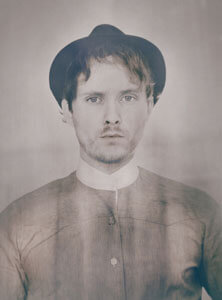Thomas Devaux has authored several complex and ambitious series. In each of them one can find a subtle but strong game of jousting played out between his core values and the evolutions brought about by modern technology. The inflammatory value behind the photography is not so innate. It is more a direct effort meant to mirror a fragment of a future re-composition.
The works in the "ATTRITION" series were selected according to their composition and their figurative will. This is a double articulation between what is borrowed and that which is a reinterpretation on one hand and an axe in art history on the other hand. "ATTRITION", thanks to the expanded possibilities of digital techniques of which I have become very experienced, shows a n affluence of forms and materials such as an organic proliferation of hair, of body parts, etc. The portrait becomes a division of a face created by itself or vanishes in its own contour. The development material, though shadowy and opaque, is light and see-through. It raises the texture of the paper which allows for an automatic refinement of the forms and pigments.
The final result is both sensual and onirique in the in the very image of the models that Devaux photographs in the backstages of fashion shows. They allow him to grasp the pictorial qualities which remain anchored in this field of photography. His surface does not rely upon the thickness of painting materials but rather on an artificial yet original vocabulary which is personal and photographic."
Source: Anne Biroleau-Lemagny, General Curator Charge of Contemporary 21st Century: French National Library
Born in 1980. Lives and works in Paris.
Thomas Devaux moved frequently when he was young and he never stopped being "in motion". He moved to London after graduating from high school, and then he started his studies in Montpellier, while exploring the image in all its forms: photography, experimental cinema, painting and collage...
He achieved through this artistic extension to remove the boundary between drawing and photography. Finally, he obtained diploma of Licence in Performing Art in Paris (Paris X). Developing great interest in traveling and exploring the world, he found his place in 2006 working for a fashion magazine: Fashion Insider. He first started as a photographer and cameraman, and became the artistic director of the magazine in 2009. He attended the world's most famous fashion shows and worked in many countries (France, Italy, Brazil, Portugal, Georgia, UK, Turkey, Denmark, Cyprus...). Opening up to the world, and to all the celebrities he met and interviewed for his magazine, was the opportunity to develop and make his style recognized: Jean-Paul Gaultier, Karl Lagerfeld, John Galliano, Donatella Vercace, Sonia Rykiel, Usher, Chris Brown, Kanye West, Milla Jovovich, Beth Ditto, Pedro Almodovar...
Source: 1:1 Photo Magazine
At first sight, portraits. At second glance, the questioning. Paintings or photographs? Thomas Devaux artwork throws off. By its form as its content, it upsets any certainty. And, it is precisely though that movement that it comes to its full magnitude.
Fashion photographer, Thomas Devaux keeps from its reports thousands of shoots made behind the scenes that feed a later digital work. Indeed, in front of his screen, he cuts, deconstructs, assembles and recomposes his pictures until he creates images full of contradictions. Far from being frightened, Thomas Devaux finds with these dualities a remarkable tool to transcend the boundaries and ward off any kind of fatality. Of fashion, he likes the aesthetics but condemns the stylistic dictum and the imperative beauty. Of photography, he praises the documentary force but fears the frozen relation to time. And, from these considerations, comes out the idea of an nonconformism, un-postural, in the original meaning, as Thomas Devaux refuses any reductive normativity without denying for all that any legagy. Entitling his series "Attriction", he seems to insist on the idea of wear. A notion that does not necessarily imply deterioration. As, if the marks of time destroy some aspects, they also reveal some others. Finally, his work damages beauty to enhance it out of the conservative models. It brings together traditional approaches and opens them to modernity. It integrates the cyclic dimension of existence and reminds that what springs dies and what dies springs again with a new form.
Source: Ozarts Etc
